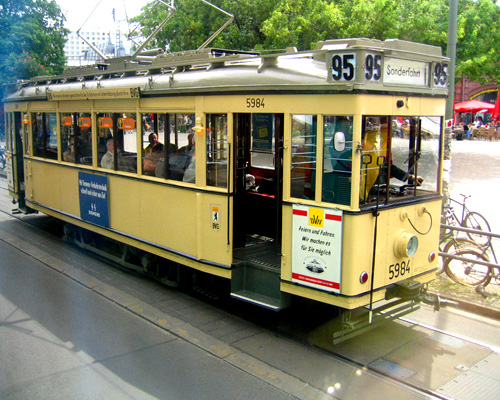One of the pleasures of visiting cities in Europe is the ability to get around easily using public transportation. In the US, only a handful of cities have the combination of subways, light rail and bus service that one finds in virtually every city in Europe.
Electric trams and streetcars, in particular, are a great alternative to diesel-powered buses, and I always use them when I can. But these light-rail vehicles are relatively rare in the US. Only Boston and San Francisco have extensive tram systems among big US cities. The irony is that America invented the streetcar, and at one time they were ubiquitous on the streets of America's cities. The traces can often be seen yet today.
But Europe adopted the electric tram and perfected it. Today, European manufacturers stand to gain from America's rediscovery of its own invention. One of the benefits of the recent spike in energy prices has been that Americans have turned to public transportation in droves, and many cities are planning light rail systems. The New York Times has a report in today's edition:
As gas prices soared and dozens of North American communities sought
to reintroduce electric streetcars as an alternative to diesel buses,
Europe’s tram builders were some of the biggest beneficiaries.
Now, as the administration of President-elect Barack Obama
contemplates an infrastructure expansion to keep Americans working
through a severe slowdown, trams may be one of the building blocks of
economic revival and energy efficiency.
“Trams were invented by the Americans,” said Jean-Noël Debroise,
vice president for product planning at Alstom, the French streetcar
builder that is selling its sleek Citadis tram to cities like Houston
and Toronto. “It’s a big market,” he said.
European companies like Alstom, Siemens of Germany, AnsaldoBreda of
Italy, CAF of Spain and Skoda of the Czech Republic will be at the head
of the line. They, along with non-European companies like Bombardier
of Canada and Kinki Sharyo of Japan, are among the leading suppliers of
streetcars, which are also known as light rail vehicles.
In the second
quarter of 2008, use of public transport rose by 5.2 percent, while
light rail use jumped 12.3 percent, according to the American Public
Transportation Association.
The biggest beneficiary of this shift to light rail is Siemens:
In May, Siemens, the market leader, landed a $277 million contract
to supply streetcars to the Utah Transit Authority. The vehicles will
be ready for service by 2012 and will be built at a Siemens factory in
Sacramento.
This year, Siemens signed a $184 million order for a new light rail line in Denver.
president and chief executive of Siemens Transportation Systems. “We
began with an initial, small order” that eventually mushroomed into a
substantial commitment. Siemens first delivered eight streetcars to
Denver in 1993; the last order was for 55 cars, and Mr. Hauck expects
more.
Let's hope that the adoption of streetcars continues, even as fuel prices have fallen to 3-year lows because of the economic slowdown. I believe that the period of high prices shocked many Americans into permanently changing their behaviors; they will not revert back to their old gas-guzzling ways.


